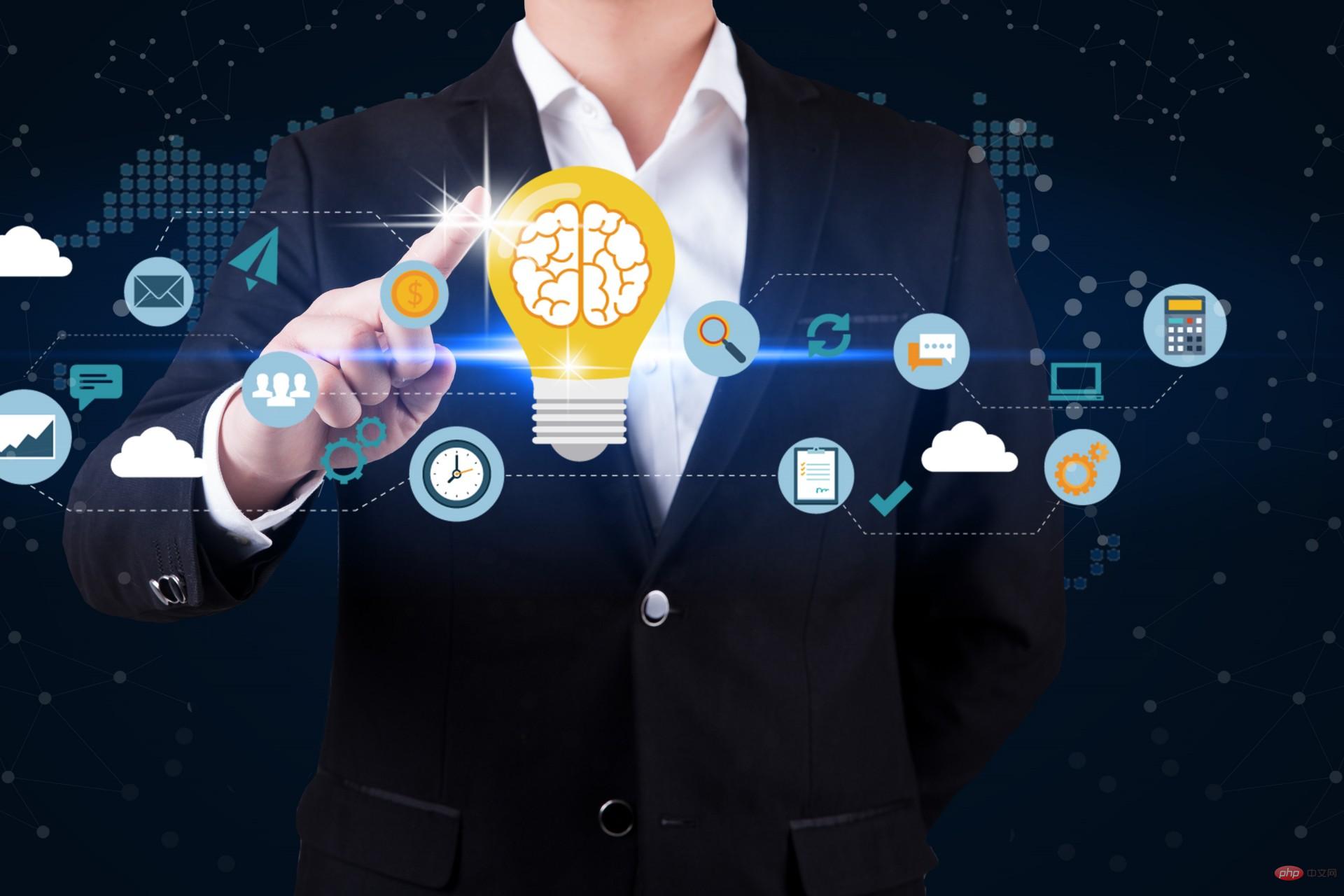The core of artificial intelligence: 1. Computer vision refers to the ability of computers to recognize objects, scenes and activities from images; 2. Machine learning refers to the fact that computer systems do not need to follow explicit program instructions; 3. Natural language processing; 4. Robots; 5. Speech recognition, which mainly focuses on automatic and accurate transcription of human speech technology.

The operating environment of this article: Windows 7 system, Dell G3 computer.
The core of artificial intelligence:
1. Computer vision
Computer vision refers to computers identifying objects from images , scene and activity capabilities. Computer vision techniques use sequences of image processing operations and other techniques to break down image analysis tasks into manageable chunks. For example, some techniques can detect the edges and textures of objects from images, and classification techniques can be used to determine whether the identified features represent a class of objects known to the system.
Computer vision has a wide range of applications, including: medical imaging analysis is used to improve disease prediction, diagnosis and treatment; facial recognition is used by Facebook to automatically identify people in photos; it is used in the security and surveillance fields used to identify suspects; and when it comes to shopping, consumers can now take photos of products with their smartphones to gain more purchasing options.
Machine vision, as a related discipline, generally refers to vision applications in the field of industrial automation. In these applications, computers identify objects such as production parts in highly constrained factory environments, making the goals simpler than computer vision that seeks to operate in unconstrained environments. Computer vision is an ongoing research, while machine vision is a "solved problem", a system engineering topic rather than a research level topic. As applications continue to expand, some computer vision startups have attracted hundreds of millions of dollars in venture capital since 2011.

#2. Machine learning
Machine learning refers to the fact that the computer system does not need to follow explicit program instructions, but only relies on data to improve their own performance. At its core, machine learning automatically discovers patterns in data, and once discovered, patterns can be used to make predictions. For example, if a machine learning system is given a database of credit card transaction information such as transaction time, merchant, location, price and whether the transaction was legitimate, the system will learn patterns that can be used to predict credit card fraud. The more transaction data processed, the more accurate the predictions will be.
Machine learning has a wide range of applications, and it has the potential to improve the performance of almost any activity that generates huge amounts of data. In addition to fraud screening, these activities include sales forecasting, inventory management, oil and gas exploration, and public health. Machine learning technology also plays an important role in other cognitive technology fields, such as computer vision, which can improve its ability to recognize objects by continuously training and improving visual models in massive images.
Today, machine learning has become one of the hottest research areas in cognitive technology, attracting nearly US$1 billion in venture capital between 2011 and 2014. Google also spent $400 million in 2014 to acquire Deepmind, a company that researches machine learning technology.

#3. Natural language processing
Natural language processing refers to the human-like text processing capabilities that computers have. For example, extract meaning from text, and even independently interpret meaning from texts that are readable, natural in style, and grammatically correct. A natural language processing system does not understand the way humans process text, but it can skillfully process text in very complex and sophisticated ways. For example, automatically identify all the people and places mentioned in a document; identify the core topics of the document; extract various terms and conditions from a pile of human-readable contracts and create a table. These tasks are simply impossible to accomplish with traditional text processing software, which only performs simple text matching and patterns.
Natural language processing, like computer vision technology, integrates various technologies that help achieve the goal. Language models are built to predict the probability distribution of language expressions, for example, the maximum likelihood that a given string of characters or words expresses a specific semantic meaning. The selected features can be combined with certain elements in the text to identify a piece of text. By identifying these elements, certain types of text can be distinguished from other text, such as spam emails from normal emails. Classification methods driven by machine learning will become the filtering criteria used to determine whether an email is spam.
Поскольку контекст очень важен для понимания разницы между «таймингами» и «дрозофилами», практическое применение технологии обработки естественного языка относительно узко. Эти области включают анализ мнений клиентов о товаре, отзывы о конкретных продуктах и услугах, автоматическое раскрытие определенных последствий в гражданских исках или правительственных расследованиях, автоматическое написание шаблонных эссе о таких вещах, как корпоративные доходы и спорт, и многое другое.

# Интегрируйте когнитивные технологии, такие как машинное зрение и автоматическое планирование, в чрезвычайно маленькие, но высокопроизводительные датчики и исполнительные механизмы. Помимо продуманного оборудования, это привело к появлению нового поколения роботов, способных работать вместе с людьми и гибко решать различные задачи в различных неизвестных средах. Например, дроны, «коботы», которые могут делиться работой с людьми в цехе и т. д.
######5. Распознавание речи#########Распознавание речи в основном связано с автоматической и точной расшифровкой человеческой речи. Технология должна столкнуться с некоторыми проблемами, аналогичными обработке естественного языка, с некоторыми трудностями в обработке различных акцентов, фонового шума, различении омофонов/синонимов («купить» и «по» звучат одинаково), и в то же время вам также необходимо быть способен работать со скоростью, соответствующей нормальной скорости речи. Системы распознавания речи используют некоторые из тех же методов, что и системы обработки естественного языка, дополненные другими методами, такими как акустические модели, которые описывают звуки и вероятность их появления в определенных последовательностях и языках. Основные приложения распознавания речи включают медицинскую диктовку, голосовое письмо, голосовое управление компьютерными системами, обслуживание клиентов по телефону и т. д. Например, Domino's Pizza недавно запустила мобильное приложение, которое позволяет пользователям размещать заказы с помощью голоса. ######Для получения дополнительной информации посетите колонку ###FAQ###! ###The above is the detailed content of What is the core of artificial intelligence. For more information, please follow other related articles on the PHP Chinese website!
 2023年机器学习的十大概念和技术Apr 04, 2023 pm 12:30 PM
2023年机器学习的十大概念和技术Apr 04, 2023 pm 12:30 PM机器学习是一个不断发展的学科,一直在创造新的想法和技术。本文罗列了2023年机器学习的十大概念和技术。 本文罗列了2023年机器学习的十大概念和技术。2023年机器学习的十大概念和技术是一个教计算机从数据中学习的过程,无需明确的编程。机器学习是一个不断发展的学科,一直在创造新的想法和技术。为了保持领先,数据科学家应该关注其中一些网站,以跟上最新的发展。这将有助于了解机器学习中的技术如何在实践中使用,并为自己的业务或工作领域中的可能应用提供想法。2023年机器学习的十大概念和技术:1. 深度神经网
 人工智能自动获取知识和技能,实现自我完善的过程是什么Aug 24, 2022 am 11:57 AM
人工智能自动获取知识和技能,实现自我完善的过程是什么Aug 24, 2022 am 11:57 AM实现自我完善的过程是“机器学习”。机器学习是人工智能核心,是使计算机具有智能的根本途径;它使计算机能模拟人的学习行为,自动地通过学习来获取知识和技能,不断改善性能,实现自我完善。机器学习主要研究三方面问题:1、学习机理,人类获取知识、技能和抽象概念的天赋能力;2、学习方法,对生物学习机理进行简化的基础上,用计算的方法进行再现;3、学习系统,能够在一定程度上实现机器学习的系统。
 超参数优化比较之网格搜索、随机搜索和贝叶斯优化Apr 04, 2023 pm 12:05 PM
超参数优化比较之网格搜索、随机搜索和贝叶斯优化Apr 04, 2023 pm 12:05 PM本文将详细介绍用来提高机器学习效果的最常见的超参数优化方法。 译者 | 朱先忠审校 | 孙淑娟简介通常,在尝试改进机器学习模型时,人们首先想到的解决方案是添加更多的训练数据。额外的数据通常是有帮助(在某些情况下除外)的,但生成高质量的数据可能非常昂贵。通过使用现有数据获得最佳模型性能,超参数优化可以节省我们的时间和资源。顾名思义,超参数优化是为机器学习模型确定最佳超参数组合以满足优化函数(即,给定研究中的数据集,最大化模型的性能)的过程。换句话说,每个模型都会提供多个有关选项的调整“按钮
 得益于OpenAI技术,微软必应的搜索流量超过谷歌Mar 31, 2023 pm 10:38 PM
得益于OpenAI技术,微软必应的搜索流量超过谷歌Mar 31, 2023 pm 10:38 PM截至3月20日的数据显示,自微软2月7日推出其人工智能版本以来,必应搜索引擎的页面访问量增加了15.8%,而Alphabet旗下的谷歌搜索引擎则下降了近1%。 3月23日消息,外媒报道称,分析公司Similarweb的数据显示,在整合了OpenAI的技术后,微软旗下的必应在页面访问量方面实现了更多的增长。截至3月20日的数据显示,自微软2月7日推出其人工智能版本以来,必应搜索引擎的页面访问量增加了15.8%,而Alphabet旗下的谷歌搜索引擎则下降了近1%。这些数据是微软在与谷歌争夺生
 荣耀的人工智能助手叫什么名字Sep 06, 2022 pm 03:31 PM
荣耀的人工智能助手叫什么名字Sep 06, 2022 pm 03:31 PM荣耀的人工智能助手叫“YOYO”,也即悠悠;YOYO除了能够实现语音操控等基本功能之外,还拥有智慧视觉、智慧识屏、情景智能、智慧搜索等功能,可以在系统设置页面中的智慧助手里进行相关的设置。
 人工智能在教育领域的应用主要有哪些Dec 14, 2020 pm 05:08 PM
人工智能在教育领域的应用主要有哪些Dec 14, 2020 pm 05:08 PM人工智能在教育领域的应用主要有个性化学习、虚拟导师、教育机器人和场景式教育。人工智能在教育领域的应用目前还处于早期探索阶段,但是潜力却是巨大的。
 30行Python代码就可以调用ChatGPT API总结论文的主要内容Apr 04, 2023 pm 12:05 PM
30行Python代码就可以调用ChatGPT API总结论文的主要内容Apr 04, 2023 pm 12:05 PM阅读论文可以说是我们的日常工作之一,论文的数量太多,我们如何快速阅读归纳呢?自从ChatGPT出现以后,有很多阅读论文的服务可以使用。其实使用ChatGPT API非常简单,我们只用30行python代码就可以在本地搭建一个自己的应用。 阅读论文可以说是我们的日常工作之一,论文的数量太多,我们如何快速阅读归纳呢?自从ChatGPT出现以后,有很多阅读论文的服务可以使用。其实使用ChatGPT API非常简单,我们只用30行python代码就可以在本地搭建一个自己的应用。使用 Python 和 C
 人工智能在生活中的应用有哪些Jul 20, 2022 pm 04:47 PM
人工智能在生活中的应用有哪些Jul 20, 2022 pm 04:47 PM人工智能在生活中的应用有:1、虚拟个人助理,使用者可通过声控、文字输入的方式,来完成一些日常生活的小事;2、语音评测,利用云计算技术,将自动口语评测服务放在云端,并开放API接口供客户远程使用;3、无人汽车,主要依靠车内的以计算机系统为主的智能驾驶仪来实现无人驾驶的目标;4、天气预测,通过手机GPRS系统,定位到用户所处的位置,在利用算法,对覆盖全国的雷达图进行数据分析并预测。

Hot AI Tools

Undresser.AI Undress
AI-powered app for creating realistic nude photos

AI Clothes Remover
Online AI tool for removing clothes from photos.

Undress AI Tool
Undress images for free

Clothoff.io
AI clothes remover

AI Hentai Generator
Generate AI Hentai for free.

Hot Article

Hot Tools

Dreamweaver CS6
Visual web development tools

ZendStudio 13.5.1 Mac
Powerful PHP integrated development environment

Atom editor mac version download
The most popular open source editor

SublimeText3 Mac version
God-level code editing software (SublimeText3)

Safe Exam Browser
Safe Exam Browser is a secure browser environment for taking online exams securely. This software turns any computer into a secure workstation. It controls access to any utility and prevents students from using unauthorized resources.






